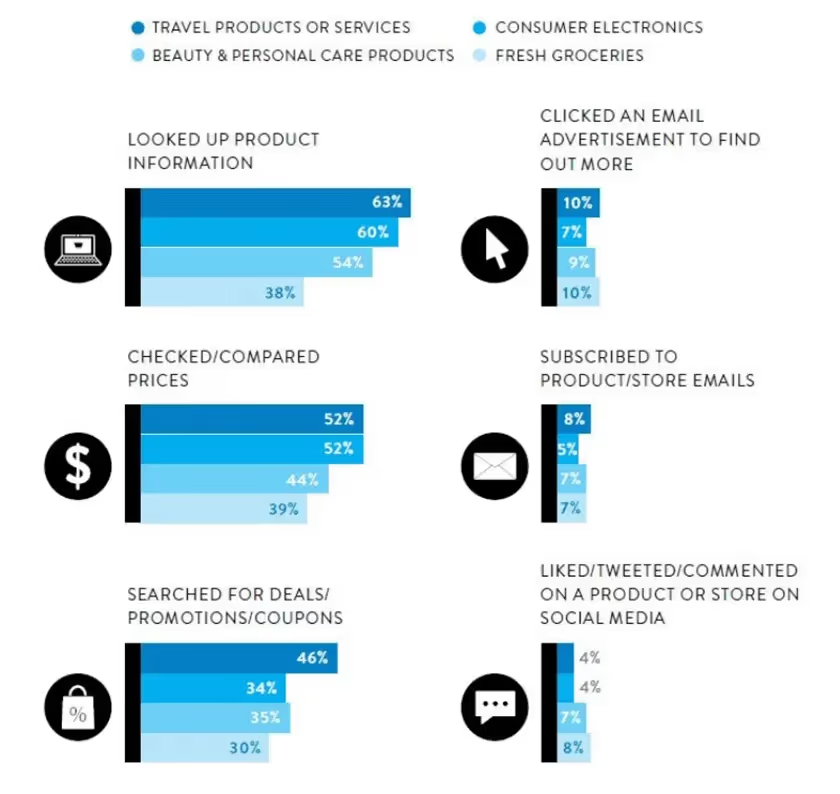How Showrooming and Webrooming Impact Ecommerce
Showrooming is crippling retail sales. But webrooming—researching products online and then buying them in stores—is how retailers can fight back.
Smartphones have become a regular part of our shopping experience. When we aren’t ordering products online, we’re reading web reviews to decide what to purchase or comparing prices from different vendors. Sometimes we’re doing it all in-store. Frequently, this behavior slips into showrooming.
What is showrooming?
Showrooming is when a customer visits a store to look for a product, then purchases that same product online from a different merchant instead. It has a lot to do with the senses. Customers like to know how a product looks and feels before they buy it, especially “big-ticket” products like electronics or furniture. Showrooming allows them to do so, then purchase the product at a lower price online.
Thus, physical stores act more like showrooms than stores and, to the dismay of retailers, lose sales. Showrooming isn’t new. Retailers have been working to curb it for years, and it’s become a regular part of the millennial shopping experience. According to a study published in Inc., Millennials participate in showrooming 30% of the time they shop.
Showrooming by category
Below are the top and bottom online shopping activities, including showrooming behavior, for specific categories over the last half of 2015, as reported by Global Connected Commerce.

Retailers at risk
Showrooming has proven to be especially widespread among some of the biggest names in the industry. A 2013 study conducted by Placed found that the top five retailers most at risk for experiencing showrooming are:
- Bed, Bath & Beyond
- PetSmart
- ToysRUs
- Best Buy
- Sears
Bed, Bath & Beyond got an index score of 127 in the Placed study. That means “showroomers” were 27% more likely to visit Bed, Bath & Beyond than the average customer. Sears’ index score was 119. In the seven years since this survey was taken, both Sears and Bed, Bath & Beyond have gone bankrupt. Scoring right beneath these retailers was Target. The company ranked less-at-risk with a score of 115, but still. That increases the likelihood of showroomers visiting their locations by 15%.
Webrooming: How retailers are fighting back
In the past, showrooming has been a tricky challenge to overcome, but retailers are finding increasing success combatting it by encouraging customers to participate in the opposite behavior: webrooming.
Webrooming is when customers research a product online first, then visit a brick and mortar store to inspect and purchase it. It works because approximately 80% of consumers are researching products online before making a purchase, and according to a study by Forbes, almost half of all retailers say their customers prefer to make their purchases in person. According to a study cited in Shopify, 69% of people webroom, and with the proper incentives in play, webrooming is helping retailers recapture sales.
Optimize webrooming with multichannel selling
One way you can maximize the effects of webrooming as a retailer is by switching to multichannel sales strategies, giving your brand an Amazon presence, a web presence, and/or a social media presence to go along with your brick-and-mortar locations. Multichannel sales not only increase revenue by upping the number of avenues by which customers can reach your company, but they also allow you to create a consistent and positive customer service experience that makes purchasing straight from your business more enticing to buyers.
With descriptive and optimized product listings, multichannel sales strategies can also help customers find you first when they’re doing their online research. That makes capturing a sale much easier.
Other webrooming incentives
Offering better in-store customer service experiences to your customers is another way to maximize the effects of webrooming for your business. Customers, especially millennial and Gen Z customers, are looking for experiences when interested in buying a product. Knowing they can have a good experience in a brick-and-mortar store (whether that’s through customer service, in-store events and deals, etc.) means they’re more likely to shop there after doing their research. Two other incentives that can help merchants capture sales from webrooming customers are:
- Offering in-store pickups for items so that customers can get them more quickly than they may be able to get them online and without the extra cost of shipping tacked on.
- Ease of returns; customers are far more likely to visit a store when they can return their product in-person rather than going through the hassle of online returns.
As webrooming becomes increasingly popular, retailers are finding more ways to minimize showrooming and make more of a profit while they’re doing it. Learn more about multichannel sales and how to best market your brand by speaking with one of our Pattern experts here.


.jpg)





.jpg)

